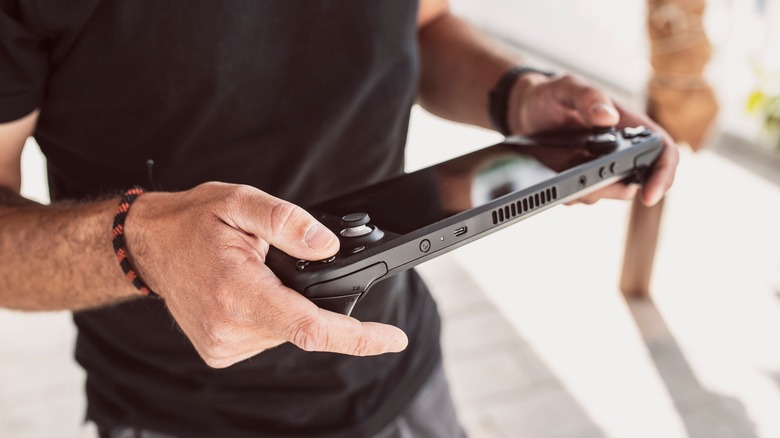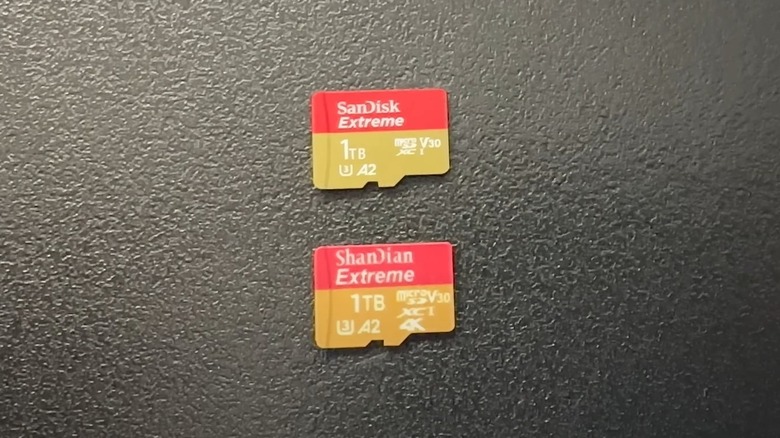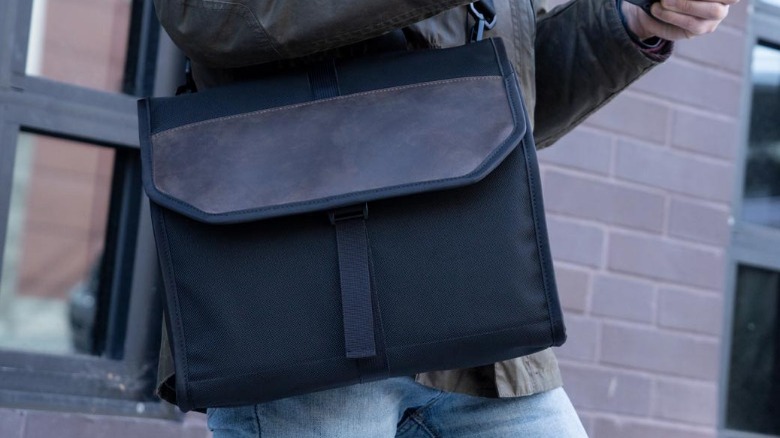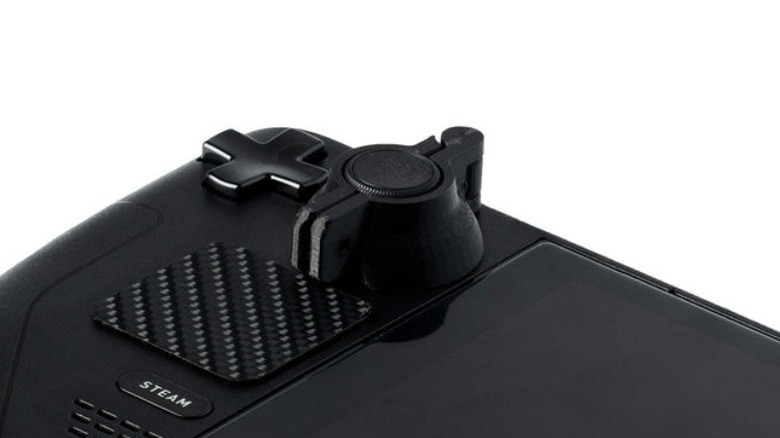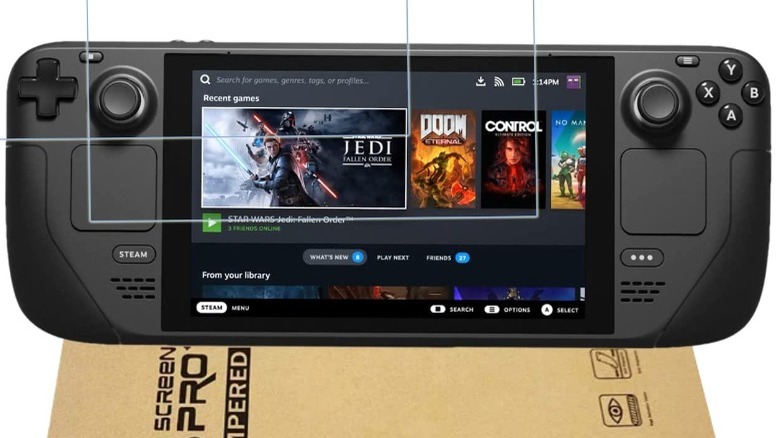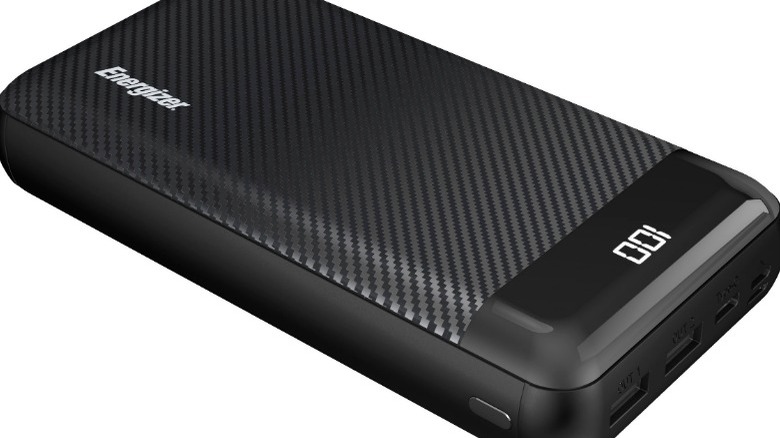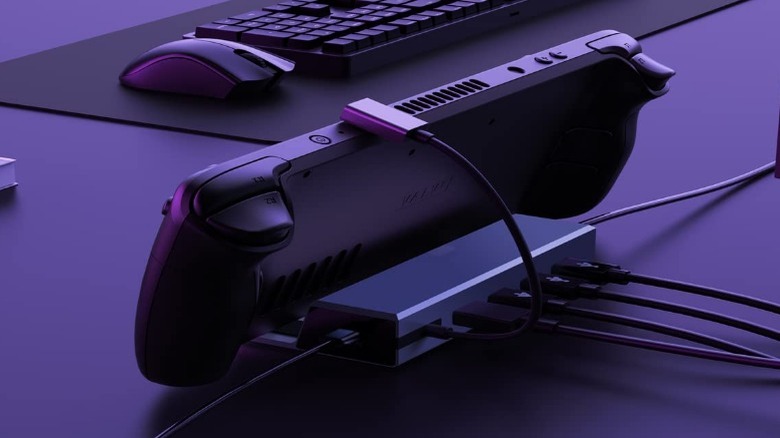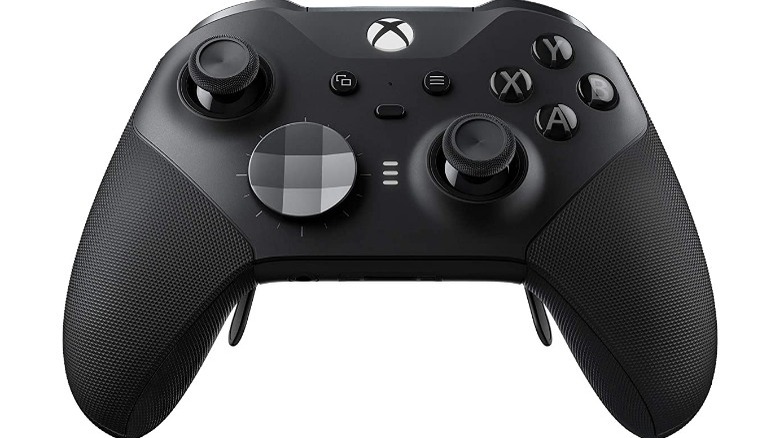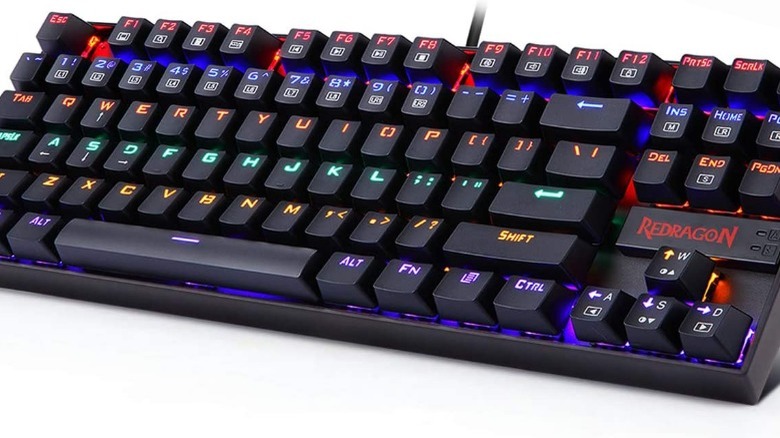Steam Deck Accessories That Are A Total Waste Of Money
The Steam Deck is a worthwhile gaming platform, which is surprising given Valve's previous dedicated console attempt, the Steam Machine. All the power of a gaming PC crammed into a portable package. Sure, the Steam Deck doesn't quite compare to custom-built computers powered by NVIDIA RTX 4090, but Valve's handheld can still run games like "Horizon Zero Dawn" just fine. And like any gaming console or PC, accessories can elevate the Steam Deck's already stellar experience.
Every gamer and their grandmother has posted a list of the best accessories for the Steam Deck. These include the normal suspects, such as carrying cases and earbuds, but also surprise inclusions like the Apple AirTag. But what if you don't want these items? What if you would rather save a few bucks on a cheaper accessory or buy a fancy one? Well, if you're not careful, you might end up wasting your money. Here is a handy guide on the kinds of accessories you should avoid.
Discount micro SD cards
The Steam Deck comes at three different price points, each of which only affects storage space. The cheapest version sports 64GB, which is enough for games such as "Hades," but not "Marvel's Spider-Man." To play (or store) more games, you need a micro SD card — but with those devices, if you try to save money the wrong way, you will only end up wasting money.
Like the Nintendo Switch, you can only expand the Steam Deck's storage with micro SD cards. While these tiny cards are generally cheaper than storage solutions for household consoles (e.g., the Xbox Series X's expansion card), micro SD cards are still hefty investments. For instance, a 512GB card costs around $65, while a 1TB card will set you back around $150. Sure, you can try to be economical by purchasing cheaper cards, but these rarely break 100GB, so they are hardly worth the money, especially if you plan on playing more recent titles. But some micro SD cards are worth even less.
Depending on where you shop, you might see micro SD cards sold at a bargain. For instance, sites like Aliexpress reportedly sell 1TB micro SD cards for as low as $7. That is certainly a steal, but not for the customer. YouTuber ReviewTechUSA tested one of these budget cards and discovered that they not only hold barely a third of their advertised amount, but computers can't even read their data. If you buy a cheap micro SD card from Aliexpress, you're asking to get scammed.
WaterField Designs Complete Case
As a handheld console, the Steam Deck is designed to fit in backpacks and carry-ons, but just because it can fit doesn't mean it's safe. As a general rule, you should place your Steam Deck in a case before taking it anywhere. Every Steam Deck comes with one for that very reason, but these are basic cases that can only store the console itself. If you want a case with a little more space, you have to buy one.
For the most part, third-party cases are a worthwhile investment. For instance, the Daydayup carrying case can hold a Steam Deck, AC adapter, earphones, HDMI cables, and micro SD cards, all for a measly $20. That's quite the bargain. But then there are cases like the WaterField Designs Complete Case, which fits all of the above plus a controller, keyboard, mouse, dock, and extra AC adapter. That product sounds like it should cost maybe $60, but instead, it costs an excessive $239.
Unfortunately, WaterField Designs' other products are also pricey. The company's "budget" Steam Deck Case, the Slip Case, fits as much as the Daydayup carrying case but is four times as expensive. And WaterField's CitySlicker costs a staggering $129 despite holding the same amount of stuff. WaterField's products are, in essence, luxury items, but the prices limit the number of people who would (or could) buy them, especially given cheaper alternatives.
Joy Guardians
Analog stick drift is the bane of modern gamers. This problem, caused by a combination of dust accumulation and wear and tear, might have initially gained infamy due to its prevalence in Nintendo Switch Joy-Cons, but it is an epidemic that affects non-Nintendo controllers as well, including Steam Decks. Nowadays, gamers are more vigilant against stick drift, which has resulted in some questionable solutions.
Third-party accessory manufacturer Glistco offers products for a variety of entertainment-centric items. The company sells replacement PlayStation 5 plates, Nerf dart rails, and Oculus Rift headphone adapters. Glitsco also sells a line of products called "Joy Guardians." For $12, these simple clamps secure the joysticks on your Xbox Series X controller, Nintendo Switch Joy-Cons (which is probably where the name came from), and the Steam Deck.
According to the Joy Guardians' item description, the clamps secure analog sticks and "completely prevent any unwanted movement while your [item] is in transit or storage." And reviews claim the Joy Guardians lock down the analog sticks as advertised, but do they prevent stick drift? Probably not. A recent study by Which? showed that "prevention cowls" don't keep enough dust out of analog sticks, and the general wear and tear that also contributes to stick drift isn't the product of just sticks moving while in storage.
Simply put, stick drift is partially a manufacturing problem, and partially the price of entertainment. Joy Guardians are a good idea in theory, but that's it.
Generic screen protectors
As a general rule of thumb, you should always buy a screen protector. These items take a hit for your phones — and now Steam Decks — and guard your devices against scratches and cracks. But screen protectors aren't a one-size-fits-all affair, and if you buy one that doesn't sit flush against your device's screen edges, what's the point?
Plenty of companies offer screen protectors designed for the Steam Deck. The most popular examples include dbrand, Benazcap, and amFilm. However, since protectors are made out of tempered glass, they are somewhat pricey — around $20 to $25. If you want to save a bit of money, you can search for sales or even budget screen protectors. But when doing so, research is your friend. Take, for example, LIBIFUN's generic screen protectors on Amazon. At $10, they sound like a great deal, but then you start reading reviews. According to customers, these panes of glass don't fit the Steam Deck screen. Instead, they extend past, preventing the protectors from adhering to the screen. Sounds like a real pain.
One might assume this problem would only be limited to one generic item, but customers report that other generic screen protectors suffer from the exact same issue. Do all of these oversized sheets come from the same factory? Regardless, these items demonstrate that sometimes paying more is worth every penny.
Incompatible power banks
Modern game consoles and controllers are battery hogs, but instead of chewing through AAs (with the exception of Xbox controllers), they rely on rechargeable batteries. It's a reasonable tradeoff, but what happens when you need to charge a Steam Deck on the go? You use a power bank, which is the go-to solution for charging smartphones when wall sockets aren't available. But, not just any power bank will do.
According to the Steam Deck website, each console comes with a 45W AC adapter. What does that mean? In layman's terms, lower wattages are designed for smaller devices and have trouble charging products meant for higher wattages. In the case of Steam Decks, any power bank with less than 45W is generally not worth it. That doesn't necessarily mean you can't buy a 35W power bank, just don't expect it to charge the Steam Deck efficiently, if at all.
When shopping for power banks for your Steam Deck, another important feature to keep in mind is capacity. The official website states the handheld console has a "40Whr battery," which translates to around 5,200 mAH (milliamp hours), the basic measuring stick for battery capacity on sites like Amazon. The higher a power bank's milliamp hour capacity, the longer it can charge a Steam Deck, which is ideal for long flights. However, the Federal Aviation Administration restricts power banks to a maximum of 100 watt-hours. Depending on who you ask and the power bank's voltage, that can be anywhere between 26,800 to 30,000 mAH. So to be safe, avoid power banks with 26,800 mAH or more if you don't want it confiscated by the TSA.
Bad earbuds and headphones
The Steam Deck is designed to be played on the go, but just because you can play "DOOM Eternal" on full blast while riding a train, doesn't mean you should. For the sake of everyone around you, you should invest in earbuds.
Since the Steam Deck comes with Bluetooth functionality and a headphone jack, you have plenty of options to ensure only you hear the action. However, not all earbuds and headphones are created equal, and when picking one to get the most out of your Steam Deck, you should research reviews to see which earbuds are worth your time and money.
Earbuds and headphones can be a waste of cash for any number of reasons. For instance, the Beats by Dr. Dre line beats the competition when it comes to sound quality, but they also beat the competition when it comes to burning holes in your wallet. Meanwhile, the House of Marley Exodus combines great sound quality with noise-canceling technology, but the headphones reportedly clamp a little too tight. You can't use this headset for more than an hour without feeling like your skull is in a vise.
Admittedly, hearing levels and ear/head shapes vary from person to person, so a headphone or earbud that is comfortable for one user might be unbearable for another. When shopping for Steam Deck sound accessories, always research your options. Paying for quality might not be worth it if the headphones give you a headache.
The Official and the Hounyoln Steam Deck Docks
One of the Nintendo Switch's best accessories is the dock. Each console comes with a dock — unless you buy the Nintendo Switch Lite, which isn't compatible with docks anyway — that lets them charge, connect to televisions, and wire into the internet. These Switch docks are somewhat plain but functional, and tons of third-party manufacturers produce their own. Unfortunately, Steam Deck owners aren't as fortunate.
The only way to obtain a Steam Deck dock is by purchasing one. Like the Switch dock, Valve's official dock charges the console and connects it to the TV and internet. However, this accessory also costs $89, which is quite frankly overpriced compared to most third-party options.
If you want a Steam Deck dock but want to save money, you are better off buying one from other providers. For instance, the premier JSAUX dock only costs $45, but it doesn't include a DisplayPort 1.4. Still, that's a small price to pay for paying a smaller price. And if that's still too much, you can always buy JSAUX's budget dock, which costs $30 and comes with one less USB port. Amazon is full of similar alternatives, such as the Hounyoln dock. Although, if you buy that item, make sure you're purchasing the cheaper $28 option, as that company also offers an $80 Steam Deck dock with a built-in 2TB card slot. Unless you plan on spending upwards of $100 on an extra SSD card for said slot, the more expensive Hounyoln dock is a waste of money.
Elite Controller and Dualsense Edge
The Steam Deck might look like a beefier Nintendo Switch, but it lacks the Switch's detachable Joy-Con controllers. So if you want to play the Steam Deck while connected to a TV via a dock, you will have to supply your own controller.
Since the Steam Deck supports Bluetooth functionality, the console can connect to any accessory that utilizes wireless technology, including modern controllers. Xbox controllers, PlayStation controllers, and even Nintendo Switch Pro Controllers are all viable options, but they lack the back buttons of the Steam Deck. If you want a controller with the same versatility, you will need either the Elite Xbox Wireless Controller 2 or the DualSense Edge. But at the same time, you also probably shouldn't buy them for your Steam Deck, either.
Now, to be fair, the Elite Xbox is a fantastic controller, and the Dualsense Edge will probably be as well (it's still not available at the time of writing). But the Elite Xbox Wireless will set you back $180, and the Dualsense Edge will cost an even heftier $200. That's a lot for any controller. Sure, you're getting extra buttons and adjustable analog sticks, but that's on top of the money you just spent on a Steam Deck. You are probably better off just buying a vanilla Xbox or PlayStation controller for $80 –$200 is just too much, even if it is for the best controller on the market.
Bad keyboards and mice
Most modern consoles have at least some compatibility with mice and keyboards, the Steam Deck included. In fact, you could consider the Steam Deck a tantamount handheld gaming PC. As such, the console can run games consoles can't, which includes titles built with mice and keyboards in mind. But as with many computer accessories, not all mice and keyboards are built the same.
Since the Steam Deck is a gaming platform, it's almost second nature to purchase gaming keyboards and mice, and that's not a bad instinct. But given the sheer number of gaming mice and keyboards out there, research should always precede purchases. For instance, you might think the Ziyou Lang X3 is a great deal, but its sensor input lag is reportedly horrendous, and that's when the sensor actually works — quick mouse movements literally break its software. Meanwhile, the Glorious Model D-, despite sporting decent performance, is notoriously flimsy and brittle.
Keyboards don't have a much better track record. For every quality gaming keyboard, you will find three akin to the Redragon K552 Kumara. On the surface, this accessory's $35 price tag sounds like a great deal, but apparently, the Redragon's keys wear out in a matter of months. Conversely, you can always buy name-brand products like Razer keyboards, which are generally more expensive, but the devil is so overt it doesn't need to hide in the details: Razer keyboards are expensive if not downright overpriced. If you can buy them on sale, go ahead, because their quality speaks for itself. Otherwise, look for a less expensive keyboard.
